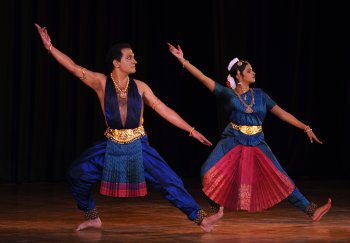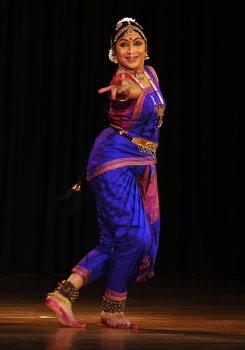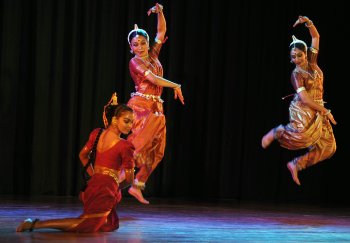
|   |

|   |
Madras Music Academy dance festival: Day 7 - Veejay Sai e-mail: vs.veejaysai@gmail.com Photos courtesy: Madras Music Academy January 27, 2013 An ideal disciple to a perfect guru  'Yatho guru thatho shishya' or 'Like guru likewise shishya' couldn't have been more apt and well-placed like it would for Aparna Ramaswamy's performance. Opening the first slot in the morning on the last day of the Music Academy's dance festival, Aparna danced her heart out to the rasikas assembled. And what better way than having her guru, the vivacious and soft-spoken Alarmel Valli support her on the nattuvangam! Was one to watch the beautiful Valli on the side of the stage or her student's performance? This was turning out to be like a heavy breakfast buffet the academy seemed to offer to the rasikas on the last day of the festival. Beginning her performance with an invocatory song in praise of mother goddess, Aparna's petit presence on stage was overpowered by the holy chants from the Durga Suktam. 'Chandram prabhasam yashasa jawalanti… tvaam padminim…' sang K P Nandini in a sweet voice. From there to 'Vellai tamarai poo' and finally to 'Yaa devi sarva bhooteshu', except for a small hitch where there was a questionable stance in her portrayal of 'alakshmi' or misfortune, Aparna paid her homage to the goddess so the morning air at the academy could get purified and energetic. The next in line was the classic oft-performed Mohamana Varnam. While dedicating this to the legendary nattuvanar gurus Subbaraya Pillai and Chokkalingam Pillai, Valli announced that the choreography contained jathis that strictly adhered to the Pandanallur baani. What more! Aparna exhibited excellent control over her movement and rendered the complex jathis with much accuracy and aplomb. Getting down to establish the nayika in the Varnam one could see the years of training Aparna put in and her hard work at getting it right. While she exhibited clarity in her nritta and abhinaya, the second half of the Varnam did seem to fatigue her a bit. She seemed visibly slow as compared to the pace in which the Varnam builds its momentum. A big chunk of this season's performances saw very few padams and javalis being performed. Fact is somehow strangely many students of dance seem to be comfortable in dancing to some bhajans and the like. While that isn't wrong, it surely doesn't add up anywhere close to performing a good padam or a javali and exploring ideas of shringaram. Gurus are to be blamed for such soft-handed approach today's young dancers take to what they present in their shows. The whole season saw an embarrassing shortage of good padams and javalis. In that light, Aparna's next item, the famous padam 'Indendu Vachchitivira, aladaani illu eeveedhi kaadu po po raa' in ragam Suruti by Melattur Kashinathayya was much appreciated. "Why have you come here? That woman's house is not on this street. How could you lose your way in this bright moonlight?" ranted Aparna totally involved as the the nayika. Displaying situations of sarcasm, anger, jealousy and the underlying feelings of hurt and sadness, Aparna's abhinaya was marked with her intense involvement. The sarcasm of the nayika asking Krishna, "You who has lifted Mount Govardhan succumb so easily to that woman's wiles?" came through well with Aparna's portrayal of the churning of the milky ocean. Just as we thought the flavor of this season was Mangalampalli Balamuralikrishna's thillanas, Aparna ended her performance with a Lalgudi thillana in ragam Ragashree, bringing things to a full circle. With crispness in her movements and clarity in footwork, Aparna's choice of presenting this thillana seemed just apt for a morning performance. Aparna's training under her diva of a guru reflected in her excellent performance. The many rumours that the Pandanallur baani was on its fade-out mode can be clearly kept aside with ardent and passionate dancers like Aparna in the field. Living far away in Minneapolis, Aparna is confident and well-bred into the art form; a quality many local dancers living in India don't posses while being closer to their gurus and the traditions of their homeland. This speaks volumes for her passion and dedication to her art. Made for each other  We have all seen dance couples over the years. Kalakshetra can be credited to engineer more dance couples than good dance soloists. It is a sheer pleasure to watch good couples if the talents of both complement each other on stage. The last day of the Music Academy's dance festival had Srikanth and Aswathy present a duet in the mid-morning slot. Watching this couple perform, one must congratulate them for the united effort they invested in the show to give a great experience. While invocatory prayers are mandatory to bring in the mood and the ambience before a performance, of late they've begun turning into full-fledged concerts. Hariprasad's invocation ended up being more of a mini-concert as everyone eagerly waited for the dancers to emerge on to the stage. The actual dance invocation, Muthuswamy Dikshitar's 'Srimahaganapatim' came in only later with Srikanth and Aswathy on stage. From the very beginning the most visible signs were those of being in total chemistry in their mirrored-movements which fed on each other's talent eventually. With over-powering aaharyam, as they danced to the commanding jathis rendered by Kuchipudi dancer turned nattuvanar Jaikishore Mosalikanti, their well-coordinated exchange of ideas was impressive. The next item, 'Rama neeve,' a Varnam in ragam Karaharapriya composed by Thenmatham Narasimhacharlu had both the dancers in a comfortable dialogue through the course of their performance. With good harmony in their impeccable nritta sequences, Srikanth brought in the theatricality of conversation that worked very well as they enacted various tales of Rama's leelas. Narrating the story of Bhakta Ramadas and his anguish in the prison, it was a sight to see Srikanth mime with just the right amount of poignancy the character deserved. They continued to describe the stories of Sita and Ahalya and other tales of Rama's beauty and valour. While everyone has watched Srikanth perform his famed stree vesham solos, it was refreshing to watch him in a completely contrasting character as a male dancer with more competence in both nritta and abhinaya, a few edges over Aswathy also. Every time a powerful jathi ended with the dancers' thumping footwork on the stage, a strange waft of smoke went up the dance floor, like some engineered special effect. It took some time to realize that Srikanth and Aswathy were actually dancing on a dusty dance floor the Academy had provided them. Though we would all like to think that the dust of Rama's feet is divine, in an overwhelming bout of spiritual ecstasy, it bothered both the performers and the rasikas to watch this little act of pollution unfold in front of their eyes. Hopefully the academy will set this right at the risk of having their first-rowers end up with a bout of bronchitis or sinusitis. Srikanth and Aswathy concluded their performance with what was announced as a 'Dhrupad' in ragam Purvi composed by Thirugokarnam Vaidyanatha Bhagavataar. Having neither the format of a Thillana nor the complex structure of what is popular as 'Dhrupad', one wondered where the source of this was. The melodious composition also saw shades of Dr. Padma Subramanyam's Bharatanrithyam with the signature twist of the waist and hand gestures. Padma should be able to solve this mystery for us with her scholarship on the subject as to why it was termed that. At several points in the performance when the mridangam player G Vijayaraghavan raced into a faulty count, nattuvanar Jaikishore diligently corrected the talam back to normalcy. Both the dancers displayed exemplary dexterity in communicating with each other, which most couples don't, in their performance. The show turned out to be one of the better-off ones in the mid-morning slot. Clogged by exhaustion  The final day's evening performances opened with a solo by Narthaki Nataraj. We have all seen Narthaki's performance and this was certainly not one of the best, unfortunately. Rumours amongst the rasikas said that she was reeling under severely bad health and was putting up a show in spite of that. Which comes to the question of why? What was the force for her to do such a mediocre show when she knew she was unwell? She could have gracefully withdrawn from the festival and the academy is able enough to put together another show in case of emergencies like they did with a quick replacement in their music season for Nithyashri Mahadevan. The academy and the rasikas also would have been more than willing to accommodate and sympathize with Narthaki and give her another chance another time. It is not even worth writing what she performed and getting into the details of how bad a show she put up. Being a protégé of the legendary Kittappa Pillai and this being the celebration of his centenary year, this was the least one would expect from Narthaki. But this performance should be a learning lesson for every dancer that on the best of your days, the most unpredictable could happen and when such things happen one must learn to gracefully accept them and move ahead. We wish Narthaki a speedy recovery into good health and will wait for her next performance, for she is certainly one of the finest upholders of the Thanjavur baani. A fitting finale The fact that selfless art can achieve what narrow-minded politics can't between the two countries was reiterated by 'Samhara,' the artistic collaboration between Bangalore based Nrityagram dance ensemble and the Chitrasena dance company from Sri Lanka. One must congratulate the Music Academy for inviting this fantastic production as a part of their festival, almost like a return gift to those who visited the Margazhi season. A thin melody of flute in the dark hall kept rasikas in eager anticipation of what was to come before the curtains were drawn open. An invocatory 'Arpanam' to celebrate the feminine divine began the evening with Nrityagram's Bijayini Satpathy, Surupa Sen and Pavithra Reddy emerging from silhouettes created out of Lynne Fernandez's exceptional lighting design. Exuding refinement par excellence they depicted the five elements in ritualistic offering to the Devi. As the percussion reached its upsurge, it seamlessly mingled with the drumming and out emerged Kandiyan dancers Thaji Dias and Mithilani Munasingha. From drumming to movement, this unique amalgamation felt like it was made for each other. Juxtaposing the thandava aspects of the Kandiyan dance and lasya characteristics of Odissi and exploring space to discover a common ground for convergence, their meticulous research reflected in the immaculate dance. It was interesting to see how the percussions from both styles also found that common link to have a rhythmic dialogue and effortlessly weave it into this exquisite tapestry. Except for the detailed narration, which seemed a bit misplaced for the rather knowledgeable audience, in 'Invoking Shiva,' Bijayini and Surupa presented a soft-handed powerful choreographic interpretation of Ravana's 'Shivathandava Stotram' sung effectively by Jateen Sahu. While their nritta got into the traditional Odissi dance vocabulary, their abhinaya to the melodious flute by Soumyaranjan Joshi brought in the much-needed stillness. In all this the musical virtuosity of the legendary Pandit Raghunath Panigrahi shone forth for the freshness in his compositions. With immense control over their bodies, as they gripped the air around the stage and created those intense moments, phrasing their work as poetry in motion would have been a severe understatement.  Following that was 'Krishna's lament' choreographed out of 'Maamiyam' from Jayadeva's 'Geeta Govindam' performed as a solo by Surupa Sen. The concept of viraham or desolation never seemed more attractive and intimate, thanks to Surupa's superb abhinaya. You empathize with her and she breaks your heart, even feel the pain. The final 'Alaap' was yet another interesting tête-à-tête of movement and rhythm between both the dance forms, each wedged to their own traditional idiom. One could watch endlessly as the five dancers elevated the air to a remarkable crescendo. As the performance concluded, a packed Music Academy received them with a standing ovation and a deafening applause. As everyone exited the hall looking as if they had been hypnotised, no one felt it right to speak beyond gesturing. The rasikas had soaked themselves completely into the experience and were happy to be lost and found to the whole process. This significantly defined the idea of 'Rasaaswaada' which all the great treatises on art extol; where energy, space and time integrate in an artistic suspension to strike a chord deep within. These are some of the most sublime of experiences that pure art strives to convey. 'Samhara' reiterated the fact that arts and artistes have no boundaries like narrow-minded politics and selfish agendas. The Music Academy's dance festival couldn't have ended with a grander finale. Veejay Sai is a writer, editor and a culture critic. |